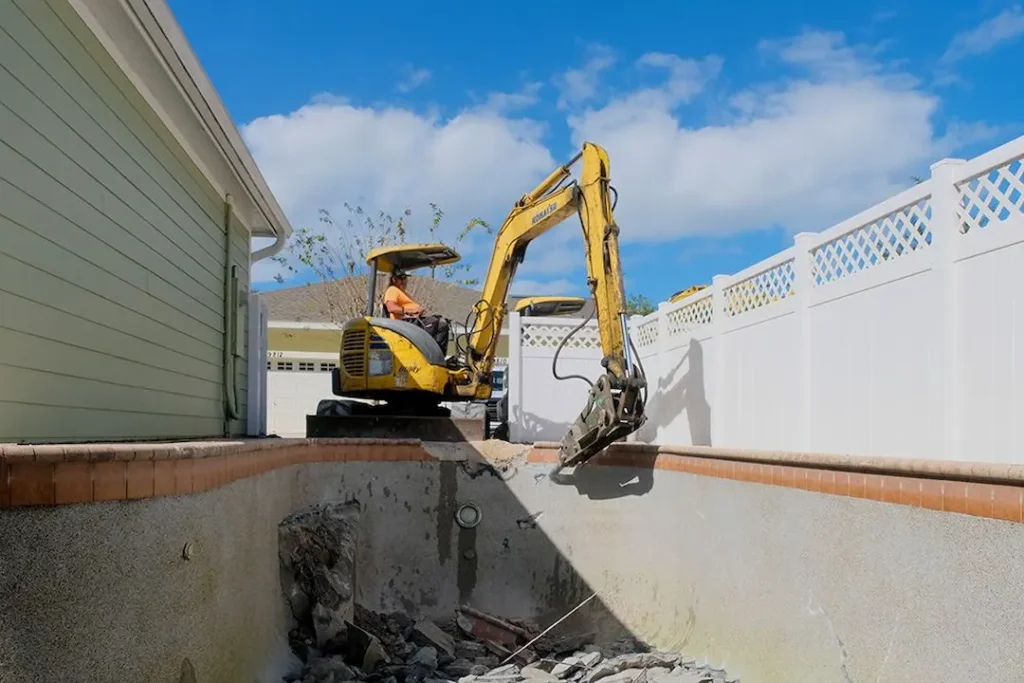Owning a swimming pool can be a wonderful luxury — but there comes a time when the upkeep, liability, and cost outweigh the benefits. If you find yourself thinking about saying goodbye to your pool, this comprehensive guide walks you through the process of full pool removal (also known as swimming pool demolition) so you know what to expect.

Content
Why remove your pool?
There are several common reasons homeowners choose pool demolition:
- The pool is no longer being used and is simply becoming a maintenance burden.
- Repair costs have become prohibitive.
- The pool poses safety and liability concerns (especially if you have small children, elderly or disabled family members).
- You’d rather reclaim that yard space for a patio, garden, lawn or play-area.
- You want to reduce water and energy use, or move toward a lower-maintenance landscaping solution.
Whatever your reason, once you’ve decided to move forward, the job falls to finding the right approach — and the right team — for removing that in‐ground pool.
Step 1: Engage a qualified demolition contractor
Pool removal is not a DIY job in most cases. A proper swimming pool demolition requires heavy equipment, safe debris disposal, site grading, drainage and sometimes utility capping. Hiring a skilled demolition contractor ensures:
- They handle permit applications (if required by your city).
- They know structural issues and site engineering.
- They manage concrete and steel removal, haul-off, backfill and compaction.
- They ensure utilities (gas, electricity, etc) are safely capped.
- You avoid mistakes like unstable ground or poor drainage that can cost you later.
Selecting your contractor: Look for someone experienced in pool removal, fully insured and licensed for demolition work. Ask for references, example jobs, and make sure their contract clearly spells out the scope, cost and schedule.
Step 2: Secure permits and plan for regulatory compliance
Depending on your area, you may need building permits, demolition permits, and inspections. You’ll also want to check for utility-line clearances and disposal/recycling regulations for concrete, steel and other debris.
For example, when removing an in-ground pool you may need a plan for drainage, compaction, and structural inspection before you can build over the former footprint.
Getting these ducks in a row early helps avoid delays and ensures your yard is safe, stable and future-ready.
Step 3: Site preparation & utility disconnection
Before any major demolition begins, the site must be prepared:
- Drain the pool and remove water safely in accordance with local regulations.
- Disconnect and cap off plumbing, electrical wiring, gas lines or other utilities that served the pool.
- Clear the deck area, fencing and any accessories (ladders, diving boards, lighting).
- Demarcate safety zones and ensure access for heavy machinery.
Proper preparation keeps the job safe, avoids surprises and makes the job smoother.
Step 4: Demolition of the pool structure
Here’s where the real “pool demolition” happens. The contractor will typically:
- Break and remove the concrete shell, coping, surrounding deck slabs.
- Remove reinforcement steel (rebar) embedded in concrete.
- Haul away the demolition debris for recycling or disposal.
- Excavate down as necessary, depending on the future use of the space.
This phase generates dust, noise and heavy traffic—good reasons to alert neighbours and coordinate logistics ahead of time.
Step 5: Backfill, compaction & grading
Once the major structure is removed, the site must be properly backfilled and graded:
- Fill the void with clean dirt, gravel or engineered fill material.
- Compact the fill in layers to prevent settling.
- Grade the surface to ensure proper drainage away from foundations and structures.
- If you’re going to build something new (patio, lawn, garage), your contractor may coordinate with a structural engineer or landscaper for final approvals and testing.
Proper compaction and grading are critical—unsafe or unstable fill can lead to future problems such as sinking ground or water pooling.
Step 6: Re-imagining the space / post-demolition landscaping
Once the pool is gone and the ground is stable, you have a blank canvas. Popular options include:
- Installing a patio, outdoor kitchen or fire pit area for entertainment.
- Laying low-maintenance lawn or artificial turf.
- Creating a garden, playcourt, or yard for pets.
- Building a new structure (shed, garage, guesthouse) if your local zoning allows.
It’s worth planning your post-demolition landscape in advance, so you’re ready when the contractor finishes. Proper coordination ensures everything flows smoothly from pool removal to your new yard space.
Step 7: Final inspection, sign-off & warranties
After the job is done:
- Ensure all permits and inspections are signed off (especially if you plan to build over the site).
- Ask for documentation of compaction tests, utility safe-cut reports and debris recycling receipts.
- Confirm your contractor’s warranty or guarantee on workmanship.
- Keep all documentation in case you sell the home: a well-documented pool removal can be a selling point if you’ve created a low-maintenance yard rather than leaving a defunct pool.
Tips to keep in mind
- Get multiple quotes from reputable demolition contractors and compare not just cost, but scope, recycling plans and timelines.
- Ask about environmental considerations: recycling concrete, reusing fill, responsible disposal of plumbing and wiring.
- Clarify whether adjoining landscaping or patio work is included or a separate expense.
- Consider timing: demolition in off-season may yield lower rates and smoother scheduling.
- Beware of subcontractors or unlicensed operators — always verify licensure and insurance.
- Plan for downtime: there may be heavy machinery, noise and restricted access during the removal process.
In summary
Removing an in-ground pool is a major project—but one with real advantages if the pool no longer serves your lifestyle. By working with a knowledgeable demolition contractor, securing the proper permits, preparing the site carefully, and following through with sound backfill and grading, you can convert a distressed or unused pool into valuable yard space. Once the structure is gone, you have a clean slate ready for new landscaping, entertainment space or whatever best fits your home and family. With proper planning and execution, you’ll regain your yard and peace of mind.

I am Javier and my love is writing about home improvement. I write mostly about home ideas, but also share some tips and tricks that can make your life easier when it comes to getting things done in the house.

